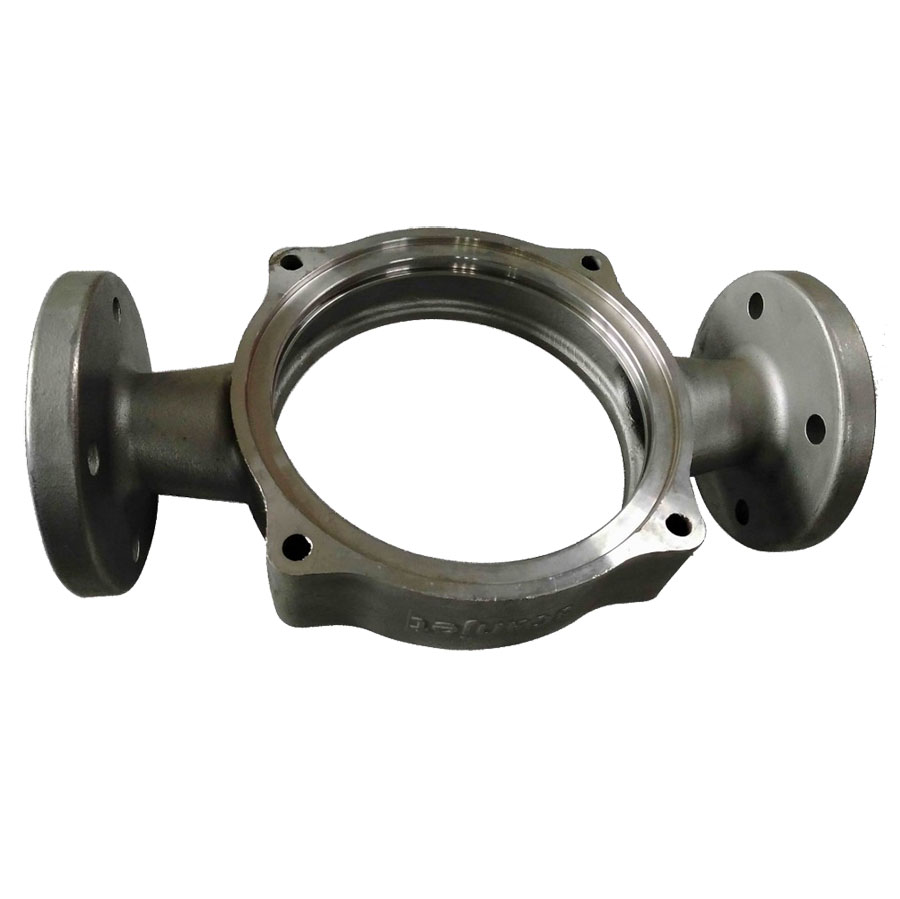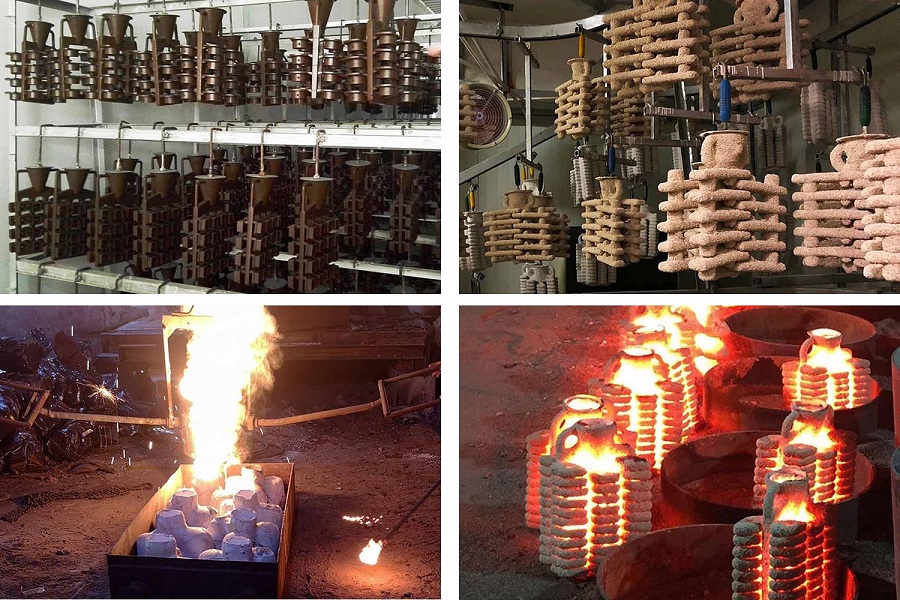
Cast Stainless Steel Investment Casting
Material: Cast Stainless Steel Process: Lost Wax Investment Casting + CNC Machining Weight: 1.50 kg Heat Treatment: Solid Solution
The main purpose of solid solution treatment of stainless steel castings is to dissolve carbides or other precipitated phases in solid solution to obtain a supersaturated single-phase structure.
Cast Stainless Steel Investment Casting
Stainless steel has a minimum chromium content of 10.5%, making it more resistant to corrosive liquid environments and to oxidation. It is highly corrosion resistant and wear resistant, provides excellent machinability, and is well-known for its aesthetic appearance. Stainless steel investment castings are "corrosion-resistant" when used in liquid environments and vapors below 1200°F (650°C) and "heat-resistant" when used above this temperature.
The choice of solution temperature depends on the chemical composition and phase diagram of the cast steel. The temperature of austenitic manganese steel castings is generally 1000 ℃ - 1100 ℃; the temperature of austenitic chromium-nickel stainless steel castings is generally 1000℃-1250℃.
The heat treatment of steel castings is based on the Fe-Fe3C phase diagram to control the microstructure of the steel castings to achieve the required performance. Heat treatment is one of the important processes in the production of steel castings. The quality and effect of heat treatment are directly related to the final performance of steel castings.
| Investment Casting Technical Data at RMC | |
| R&D | Software: Solidworks, CAD, Procast, Pro-e |
| Lead Time for Development and Samples: 25 to 35 days | |
| Molten Metal | Ferritic Stainless Steel, Martensitic Stainless Steel, Austenitic stainless steel, Precipitation Hardening Stainless Steel, Duplex Stainless Steel |
| Carbon Steel, Alloy Steel, Tool Steel, Heat Resistant Steel, | |
| Nickle-base Alloy, Aluminium Alloy, Copper-base Alloy, Cobalt-base Alloy | |
| Metal Standard | ISO, GB, ASTM, SAE, GOST EN, DIN, JIS, BS |
| Material for Shell Building | Silica Sol (Precipitated Silica ) |
| Water Glass (Sodium Silicate) | |
| Mixtures of Silica Sol and Water Glass | |
| Technical Parameter | Piece Weight: 2 gram to 200 kilo gram |
| Max Dimension: 1,000 mm for Diameter or Length | |
| Min Wall Thickness: 1.5mm | |
| Casting Roughness: Ra 3.2-6.4, Machining Roughness: Ra 1.6 | |
| Tolerance of Casting: VDG P690, D1/CT5-7 | |
| Tolerance of Machining: ISO 2768-mk/IT6 | |
| Inner Core: Ceramic Core, Urea Core, Water Soluble Wax Core | |
| Heat Treatment | Normalizing, Tempering, Quenching, Annealing, Solution, Carburization. |
| Surface Treatment | Polishing, Sand / Shot Blasting, Zinc Plating, Nickel Plating, Oxidation Treatment, Phosphating, Powder Painting, Geormet, Anodizing |
| Dimension Testing | CMM, Vernier Caliper, Inside Caliper. Depth Gage, Height Gage, Go/No go Gauge, Special Fixtures |
| Chemical Inspection | Chemical Compostion Analysis (20 chemical elements), Cleanliness Inspection, X-ray Radiographic Inspection, Carbon-Sulfur Analyser |
| Physical Inspection | Dynamic Balancing, Static Blancing, Mechanical Properties (Hardness, Yield Strength, Tensile Strength), Elongation |
| Production Capacity | More than 250 tons per month, more than 3,000 tons annually. |
▶ Capabilities of Stainless Steel Investment Casting Foundry
• Max Size: 1,000 mm × 800 mm × 500 mm
• Weight Range: 0.5 kg - 100 kg
• Annual Capacity: 2,000 tons
• Bond Materials for Shell Building: Silica Sol, Water Glass and their mixtures.
• Tolerances: On Request.
▶ Main Production Procedure of Stainless Steel Investment Casting
• Patterns & Tooling Design → Metal Die Making → Wax Injection → Slurry Assembly → Shell Building → De-Waxing → Chemical Composition Analysis → Melting & Pouring → Cleaning, Grinding & Shot Blasting → Post Processing or Packing for Shipment
▶ Inspecting Stainless Steel Lost Wax Castings
• Spectrographic and manual quantitative analysis
• Metallographic analysis
• Brinell, Rockwell and Vickers hardness inspection
• Mechanical property analysis
• Low and normal temperature impact testing
• Cleanliness inspection
• UT, MT and RT inspection
▶ Post-Casting Process
• Deburring & Cleaning
• Shot Blasting / Sand Peening
• Heat Treatment: Normalization, Quench, Tempering, Carburization, Nitriding
• Surface Treatment: Passivation, Anodizing, Electroplating, Hot Zinc Plating, Zinc Plating, Nickel Plating, Polishing, Electro-Polishing, Painting, GeoMet, Zintec.
• Machining: Turning, Milling, Lathing, Drilling, Honing, Grinding.
▶ Advantages of Steel Investment Casting Components:
• Excellent and smooth surface finish
• Tight dimensional tolerances.
• Complex and intricate shapes with design flexibility
• Capability to cast thin walls therefore a lighter casting component
• Wide selection of cast metals and alloys (ferrous and non-ferrous)
• Draft is not required in the molds design.
• Reduce the need for secondary machining.
• Low material waste.
▶ Why You Choose RMC for Steel Custom Lost Wax Casting Parts?
• Full solution from one single supplier ranging customized pattern design to finished castings and secondary process including CNC machining, heat treatment and surface treatment.
• Costdown proposals from our professional engineers based on your unique requirement.
• Short leadtime for prototype, trial casting and any possible technical improvement.
• Bonded Materials: Silica Col, Water Glass and their mixtures.
• Manufacturing flexibility for small orders to mass orders.
• Strong outsourcing manufacturing capabilities.
To know better about our capabilities of lost wax casting process, please click the following picture to turn to our page of Investment Casting Capabilities:
 русский
русский




